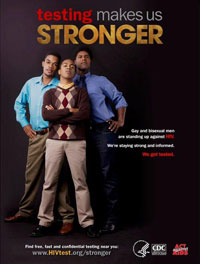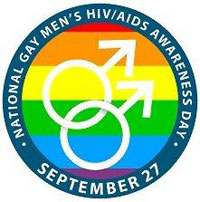National Gay Men's HIV/AIDS Awareness Day
 National Gay Men's HIV/AIDS Awareness Day is a national effort founded by the National Association of People with AIDS to raise awareness of the HIV/AIDS epidemic among gay and bisexual men.
National Gay Men's HIV/AIDS Awareness Day is a national effort founded by the National Association of People with AIDS to raise awareness of the HIV/AIDS epidemic among gay and bisexual men.
Gay Men and HIV/AIDS

The Let's Stop HIV Together campaign raises awareness about HIV and its impact on the lives of all Americans and fights stigma.
Gay and bisexual men remain among those most affected by HIV. While these men represent approximately 2% of the overall U.S. population, they accounted for 61% of all new HIV infections in 2009, and men who have sex with men (MSM) with a history of injection drug use (MSM-IDU) accounted for an additional 3% of new infections.
Since the first cases of AIDS were reported in five gay men in 1981, many advances in HIV research, prevention, and treatment have been made. Prevention efforts have helped reduce new infections, and treatment advances have allowed people with HIV to live longer, healthier lives. Gay and bisexual men have often been at the forefront of these efforts. Many have been instrumental in raising awareness about the public health impact of HIV, shaping the research agenda, and ensuring that research is well funded.
More Frequent Testing
Knowledge of one's HIV status and linkage to care and treatment are of utmost importance. Because sexually active gay and bisexual men are at increased risk for HIV infection, CDC recommends they be tested for HIV infection at least annually. CDC suggests more frequent testing (every 3 to 6 months) for gay and bisexual men at high risk—including those who have multiple or anonymous partners, who have sex in conjunction with illicit drug use, or whose partners participate in these activities.
High Impact Prevention

The Testing Makes Us Stronger campaign encourages black gay and bisexual men aged 18 to 44 to get tested for HIV.
Reducing the impact of HIV among gay and bisexual men is a top CDC priority and demands that we target our efforts and expand our reach. To maximize every dollar and prevent the greatest number of new infections, CDC is pursuing High-Impact HIV Prevention [PDF - 260KB] activities to reach the aggressive goals of the National HIV/AIDS Strategy. One goal is to increase the proportion of HIV-diagnosed gay and bisexual men with undetectable viral load by 20% by 2015. To meet this goal, CDC is working with prevention partners to implement programs for gay and bisexual men, such as testing initiatives, biomedical and behavioral interventions, treatment and education efforts for gay and bisexual men living with HIV, and social marketing campaigns.
For example, a recent multi-national study indicated that HIV infection among gay and bisexual men can be reduced by pre-exposure prophylaxis (PrEP), a new HIV prevention method in which persons at high risk for HIV but who do not have HIV take a once-daily pill to reduce their risk of becoming infected. For gay and bisexual men at high risk for HIV, PrEP may represent a much-needed additional prevention method; however, it will not be right for everyone. PrEP is an intensive approach that requires strict adherence to daily medication and regular HIV testing in combination with other HIV prevention methods. If it is used correctly by persons at very high risk, PrEP may play a role in helping to reduce the number of new HIV infections in the United States. CDC has published interim guidance for clinicians on the use of PrEP.
Another example is Act Against AIDS, a 5-year multifaceted communication campaign launched by CDC and the White House to combat complacency about HIV and AIDS in the United States. Two recent Act Against AIDS campaigns include messages for gay and bisexual men:
- The Testing Makes Us Stronger campaign encourages black gay and bisexual men aged 18 to 44 (with an emphasis on 18- to 24-year-olds) to get tested for HIV. The campaign includes ads in national magazines and on targeted websites, local advertising and materials distribution in targeted cities, a Facebook page, and a dedicated website with a suite of campaign materials that are available for individuals and organizations to download and distribute.
- The Let's Stop HIV Together campaign raises awareness about HIV and its impact on the lives of all Americans, and fights stigma by showing that people with HIV are mothers, fathers, friends, brothers, sisters, sons, daughters, partners, wives, husbands, and coworkers.
What Can You Do?
- Find out about HIV, sexually transmitted diseases (STDs), and other health issues that affect gay and bisexual men.
- Get tested for HIV. To find a testing site near you, visit the National HIV and STD Testing Resources site, text your ZIP code to Know IT (566948), or call 1-800-CDC-INFO (232-4636).
- Abstain from (do not have) sex, be in a long-term mutually monogamous relationship with an uninfected partner, or limit your number of sex partners. The fewer partners you have, the less likely you are to have sex with someone who is infected with HIV or another STD.
- Use condoms correctly and consistently. Latex condoms are highly effective at preventing transmission of HIV and some other STDs. "Natural" or lambskin condoms do not provide protection against HIV infection.
- If you are living with HIV, make sure you get life-extending care and treatment and learn how to prevent transmission to others.
- Speak out against stigma, homophobia, racism, and other forms of discrimination associated with HIV and AIDS.
More Information
Get email updates
To receive email updates about this page, enter your email address:
Contact Us:
- Centers for Disease Control and Prevention
1600 Clifton Rd
Atlanta, GA 30333 - 800-CDC-INFO
(800-232-4636)
TTY: (888) 232-6348 - Contact CDC-INFO




